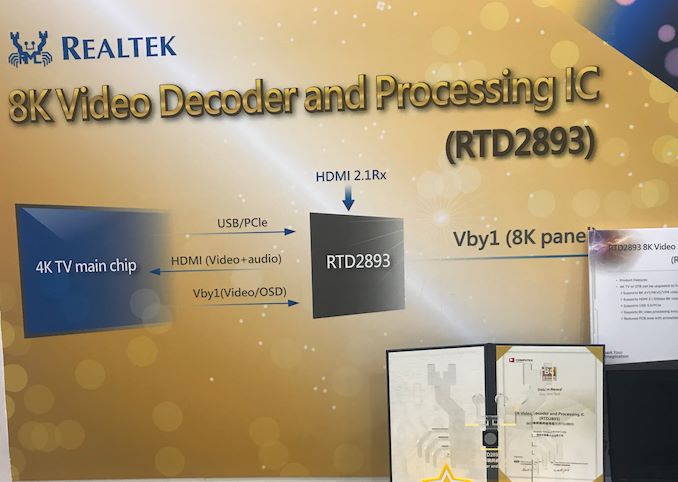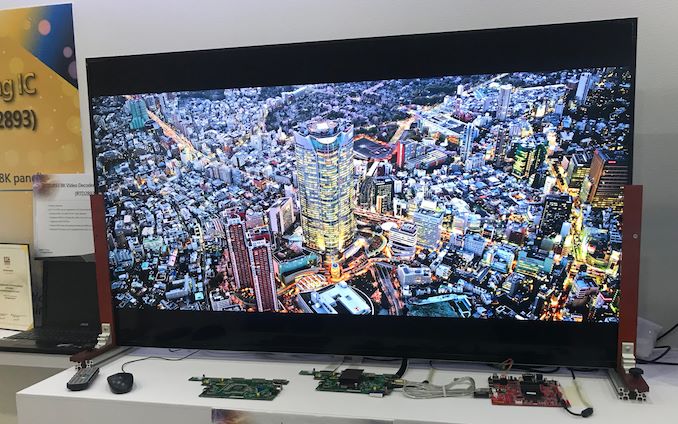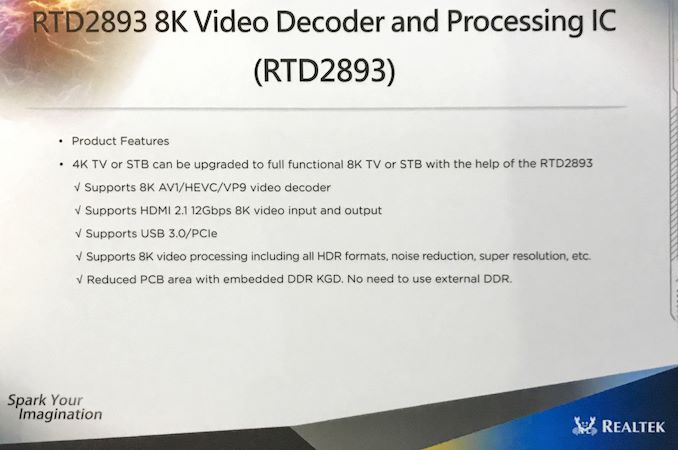Realtek Demonstrates RTD2893: A Platform for 8K Ultra HD TVs
by Anton Shilov on June 19, 2019 10:00 AM EST- Posted in
- Monitors
- Displays
- Trade Shows
- UltraHD
- Realtek
- 8K
- Computex 2019

Just like with any other major transitions, the shift to 8K Ultra HD TVs will require not only new display panels (and even new display technologies), new cables, and new media, but also new codecs as well as new SoCs. To this end, Realtek demonstrated its first platform for 8K televisions and Ultra HD set-top-boxes/players at Computex.
Realtek’s RTD2983 SoC can support decoding 8K resolution videos encoded using the AV1, HEVC, and VP9 codecs. The chip can process all HDR formats, reduce noise, upscale, and perform all the other functions common for processors for televisions and digital media players. The RTD2983 has PCIe and USB 3.0 interfaces, it can receive data via an HDMI 2.1 48 Gbps interface, and transmit pixel data over Vby1 wires. One advantage the RTD2983 has is embedded memory, which eliminates necessity to use external DRAM devices, lowering the BOM costs for finished products.
Since Ultra HD content is scarce, Realtek demonstrated the RTD2983 platform at Computex using a static picture encoded using one of the aforementioned codecs. The lack of complex motion is a bit of a letdown here, but considering how hot the SoC's heatspreader got, Realtek certainly wasn't running a light workload here.
As for consumer applications for the new chip, Realtek ultimately brought the RTD2983 to Computex to show potential customers that it's ready, and that interested parties can start designing their devices based on the SoC. Though keeping in mind long design cycles for consumer electronics, it bears noting that we won't see Realtek's new SoC show up in finished products for a while yet. But in a year or two down the line, this is likely to be one of several SoCs we'll see at the heart of various mass-market Ultra HD boxes.
| Want to keep up to date with all of our Computex 2019 Coverage? | ||||||
 Laptops |
 Hardware |
 Chips |
||||
| Follow AnandTech's breaking news here! | ||||||













23 Comments
View All Comments
Santoval - Wednesday, June 19, 2019 - link
"Since Ultra HD content is scarce, Realtek demonstrated the RTD2983 platform at Computex using a static picture encoded using one of the aforementioned codecs."While the content itself might be scarce the equipment to shoot at 8K is not. RED already has no less than three "brains" (sensors) that can shoot at 8K with RED cameras, Panavision has the Panavision Millenium 8K DXL (with a RED sensor), Ikegami has the Ikegami SHK-810 8K camera, and even Canon is about to release the Canon Cinema EOS System S35MM 8K camera.
While the above cameras are out of reach for the average Joe, Realtek could have easily rented one of them for the demonstration, or -why not- even buy one (except the Panavision, that's rent-only) to employ as a testbed for their 8K platform.
mode_13h - Friday, June 21, 2019 - link
Yeah, considering the development costs for such an ASIC, claiming lack of test material suggests an extreme lack of resourcefulness. They could've probably even asked some of their customers or partners for 8k clips.mode_13h - Friday, June 21, 2019 - link
> Since Ultra HD content is scarce, Realtek demonstrated the RTD2983 platform at Computex using a static picture...or, the chip can't currently handle decoding full motion @ full framerate.
It's somewhat unthinkable they could bring a custom chip to this stage, without ever having run any full-motion clips with any of the target codecs. I mean, you could even render & encode some Blender scenes yourself, if you had to.
But they could also just rent an 8k digital cinema camera and shoot some scenes with it. It's really unbelievable that "they just have no clips to display". I smell a rat.